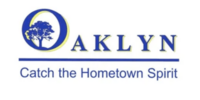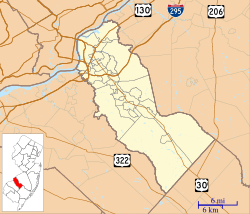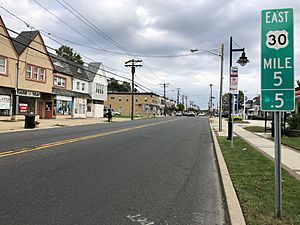Oaklyn, New Jersey facts for kids
Quick facts for kids
Oaklyn, New Jersey
|
||
|---|---|---|
|
Borough
|
||

CR 649 (West Clinton Avenue) westbound in Oaklyn
|
||
|
||
| Motto(s):
Catch the Hometown Spirit
|
||

Oaklyn highlighted in Camden County
|
||

Census Bureau map of Oaklyn, New Jersey
|
||
| Country | ||
| State | ||
| County | Camden | |
| Settled | 1681 | |
| Incorporated | March 13, 1905 | |
| Government | ||
| • Type | Borough | |
| • Body | Borough Council | |
| Area | ||
| • Total | 0.70 sq mi (1.81 km2) | |
| • Land | 0.63 sq mi (1.62 km2) | |
| • Water | 0.07 sq mi (0.18 km2) 8.70% | |
| Area rank | 531st of 565 in state 30th of 37 in county |
|
| Elevation | 26 ft (8 m) | |
| Population
(2020)
|
||
| • Total | 3,930 | |
| • Estimate
(2023)
|
3,940 | |
| • Rank | 415th of 565 in state 26th of 37 in county |
|
| • Density | 6,265.7/sq mi (2,419.2/km2) | |
| • Density rank | 84th of 565 in state 6th of 37 in county |
|
| Time zone | UTC−05:00 (Eastern (EST)) | |
| • Summer (DST) | UTC−04:00 (Eastern (EDT)) | |
| ZIP Code |
08107
|
|
| Area code(s) | 856 | |
| FIPS code | 3400753880 | |
| GNIS feature ID | 0885331 | |
Oaklyn is a borough in Camden County, in the U.S. state of New Jersey. As of the 2020 United States census, the borough's population was 3,930, a decrease of 108 (−2.7%) from the 2010 census count of 4,038, which in turn reflected a decline of 150 (−3.6%) from the 4,188 counted in the 2000 census.
The borough had the 28th-highest property tax rate in New Jersey, with an equalized rate of 4.134% in 2020, compared to 3.470% in the county as a whole and a statewide average of 2.279%.
Contents
History
Before European settlement began, Oaklyn was dense forest land which was inhabited by Lenape Native Americans. In 1681, a group of Quakers seeking religious freedom sailed from Ireland to Fenwick's Colony at Salem, New Jersey, where they spent the winter. In 1682, they sailed up the Delaware River and settled on Newton Creek. William Bates, their leader, purchased 250 acres (1.0 km2) on the south side of Newton Creek from the local Native Americans. The original Quaker settlement, known as Newton Colony, was located in The Manor section of today's Oaklyn.
The Colony began to grow rapidly and the land was cleared for farming. Eventually two highways were laid out. One, from the Delaware River to Egg Harbor, followed an old Native American trail, which is today the Black Horse Pike. The other was known as the Long-a-coming trail, which extended from Atlantic City to Berlin and then from Berlin to Camden. This trail is now known as the White Horse Pike.
After the American Revolutionary War, a group of Virginia sportsmen built a racetrack on the east side of the White Horse Pike. Future president Ulysses S. Grant visited this track as a young man before it closed in 1846. Samuel Bettle bought the land which was formerly the racetrack and eventually, the land was deeded to Haddon Township.
As the years passed, the farms along Newton Creek were divided into lots and the development called "Oakland the Beautiful", for the many trees in the area. The name was changed to Oaklyn in 1894 to avoid confusion with another Oakland in North Jersey.
Oaklyn was incorporated as a borough by an act of the New Jersey Legislature on March 13, 1905, from portions of Haddon Township.
Geography
According to the U.S. Census Bureau, the borough had a total area of 0.69 square miles (1.78 km2), including 0.63 square miles (1.62 km2) of land and 0.06 square miles (0.15 km2) of water (8.70%).
Oaklyn borders the Camden County municipalities of Audubon, Audubon Park, Camden, Collingswood, and Haddon Township.
Demographics
| Historical population | |||
|---|---|---|---|
| Census | Pop. | %± | |
| 1910 | 653 | — | |
| 1920 | 1,148 | 75.8% | |
| 1930 | 3,843 | 234.8% | |
| 1940 | 3,869 | 0.7% | |
| 1950 | 4,889 | 26.4% | |
| 1960 | 4,778 | −2.3% | |
| 1970 | 4,626 | −3.2% | |
| 1980 | 4,223 | −8.7% | |
| 1990 | 4,430 | 4.9% | |
| 2000 | 4,188 | −5.5% | |
| 2010 | 4,038 | −3.6% | |
| 2020 | 3,930 | −2.7% | |
| 2023 (est.) | 3,940 | −2.4% | |
| Population sources: 1910−2000 1910−1920 1910 1910−1930 1940–2000 2000 2010 2020 |
|||
2010 census
The 2010 United States census counted 4,038 people, 1,725 households, and 1,007 families in the borough. The population density was 6,432.9 per square mile (2,483.8/km2). There were 1,847 housing units at an average density of 2,942.4 per square mile (1,136.1/km2). The racial makeup was 92.40% (3,731) White, 2.48% (100) Black or African American, 0.22% (9) Native American, 1.81% (73) Asian, 0.02% (1) Pacific Islander, 1.49% (60) from other races, and 1.58% (64) from two or more races. Hispanic or Latino of any race were 5.37% (217) of the population.
Of the 1,725 households, 25.2% had children under the age of 18; 43.3% were married couples living together; 10.7% had a female householder with no husband present and 41.6% were non-families. Of all households, 33.4% were made up of individuals and 8.8% had someone living alone who was 65 years of age or older. The average household size was 2.34 and the average family size was 3.03.
20.5% of the population were under the age of 18, 7.7% from 18 to 24, 29.9% from 25 to 44, 30.6% from 45 to 64, and 11.3% who were 65 years of age or older. The median age was 39.4 years. For every 100 females, the population had 96.3 males. For every 100 females ages 18 and older there were 96.0 males.
The Census Bureau's 2006−2010 American Community Survey showed that (in 2010 inflation-adjusted dollars) median household income was $55,690 (with a margin of error of +/− $6,370) and the median family income was $86,019 (+/− $13,045). Males had a median income of $52,963 (+/− $6,041) versus $44,653 (+/− $12,251) for females. The per capita income for the borough was $31,168 (+/− $2,965). About 1.6% of families and 4.4% of the population were below the poverty line, including 1.4% of those under age 18 and 1.6% of those age 65 or over.
Education
Oaklyn Public School District serves students in pre-kindergarten through fifth grade. As of the 2020–21 school year, the district, comprised of one school, had an enrollment of 278 students and 28.0 classroom teachers (on an FTE basis), for a student–teacher ratio of 9.9:1. Prior to the 2018–19 school year Oaklyn Public School served students through ninth grade. Oaklyn was the last district in New Jersey that used a Kindergarten through ninth grade format.
Public school students from Oaklyn in sixth through twelfth grades attend Collingswood Middle School and Collingswood High School as part of a sending/receiving relationship with the Collingswood Public Schools that has been in place for over 40 years. As of the 2020–21 school year, the high school had an enrollment of 747 students and 67.3 classroom teachers (on an FTE basis), for a student–teacher ratio of 11.1:1.
Transportation
Roads and highways
As of May 2010[update], the borough had a total of 11.92 miles (19.18 km) of roadways, of which 7.69 miles (12.38 km) were maintained by the borough, 3.57 miles (5.75 km) by Camden County and 0.66 miles (1.06 km) by the New Jersey Department of Transportation.
U.S. Route 30 is the main highway serving Oaklyn. A small section of New Jersey Route 168 and Interstate 76 pass near the borough.
Public transportation
NJ Transit bus service between Sicklerville and Philadelphia on the 400 route, between Turnersville and Camden on the 403 route and between Cherry Hill and Camden on the 450 route.
Notable people
People who were born in, residents of, or otherwise closely associated with Oaklyn include:
- Mitch Albom (born 1958), author, journalist, screenwriter, playwright, radio and television broadcaster and musician
- William Bates (died 1700), the borough's first English settler
- Andrew Clements (1949–2019), writer of children's books, known for his debut novel Frindle
- Tom Deery (born 1960), inducted into the College Football Hall of Fame
- Ralph W. E. Donges (1875–1974), Justice of the New Jersey Supreme Court from 1930 to 1948
- Matthew Quick (born 1974), author of The Silver Linings Playbook
See also
 In Spanish: Oaklyn para niños
In Spanish: Oaklyn para niños






